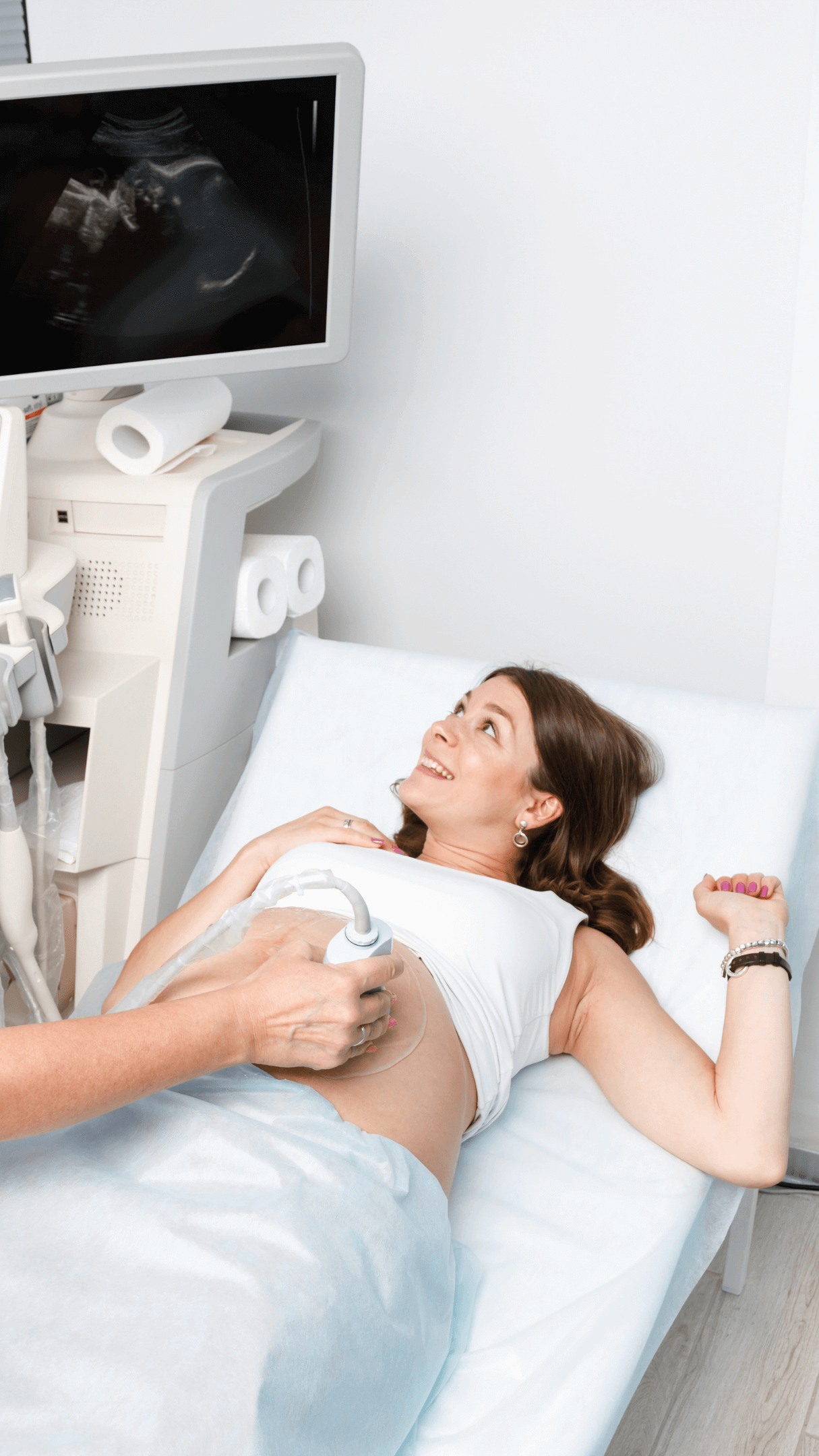GYNECOLOGY & OBSTETRICS
Now that you’re at our clinic we will decide your final treatment plan and begin your treatment on the same day.
All kinds of gynecological diseases are diagnosed and treated in our Obstetrics and Gynecology service. Our maternity ward is equipped with the latest technologies and our delivery room, newborn intensive care unit and patient rooms are open 24/7.
In the diagnosis, treatment and surgery in the department of women’s diseases and obstetrics of the Health Hospital, services are provided with the latest techniques and technologies.
Pregnancy and Childbirth
In our hospital, 5 different gynecology maternity polyclinics, pregnancy preparation checks and routine pregnancy examinations are performed with 3D/4D upper segment ultrasonography devices. In pregnancy follow-up, double-triple-four screening tests in terms of Down syndrome and genetic diseases can be applied in our hospital for non-invasive prenatal test and amniocentesis procedures from the womb.
Our pregnant women attend birth preparation courses given by our certified trainers within our hospital for a more conscious and easy birth. For our patients who are at the time of birth, there are natural vaginal birth, vaginal birth in water, vaginal birth with epidural anesthesia, cesarean delivery with combined spinal-epidural anesthesia and cesarean delivery options with general anesthesia. Our maternity rooms are designed to allow a caesarean section to be performed if necessary. In order to make this happy day of our patients more enjoyable and unforgettable, hairdresser, personalized mother-baby room designs, florist, birth photographer, video recording system service is offered in our hospital.
General gynecology and reproductive diseases
In our hospital, smear test, colposcopy, cryotherapy and catheterization procedures for cervical health can be performed. Gynecological surgeries can be performed openly (laparotomy), closed (hysteroscopic- laparoscopic) and vaginally. Digital mammography device, which is reliable in terms of breast health and has a tomosynthesis feature, has been put into the service of our patients.
Urojinecology
The latest surgical methods for genital organ sagging and urinary incontinence problems are applied to our patients as vaginal and laparoscopic.
Infertility and IVF
In our IVF-UYTE unit, spremiogram, HSG (hyterosalpingography), hysteroscopy, IVF (IVF-ICSI), sperm freezing, embryo freezing are successfully performed.
Genital Aesthetics and Laser
In our hospital, surgical methods for genital aesthetics and vaginal rejuvenation, as well as non-surgical laser techniques are used.
2 in pregnancy. Level Ultrasound
Congenital anomalies are observed in 2-3% of all births. Some of these can be corrected with medical interventions. Some of them may be with severe mental and structural disorders. There is more than one cause in structural disorders. (Genetic and environmental factors) Some anomalies are incompatible with life and the baby can be lost in the womb or after birth. Detailed Ultrasound during pregnancy is very important in order to predict all these. It is ideal to have a pregnancy between the 18th-24th week. In these weeks, the baby organs are large enough and a good image can be obtained because the baby’s water is abundant. Detailed Ultrasond uterine structure of the plesenta (baby partner) and baby are systematically examined. In the baby, the central nervous system, heart and chest cavity, stomach, intestinal system, kidney, urinary tract, heart and large vessels, and skeletal system are examined in detail. The importance of Detailed Ultrasound not only determines pregnancy that is incompatible with life, but also by following the correctable anomalies, it can be done in an environment where all the necessary facilities for the birth baby are ready.
Services Provided in Obstetrics and Gynecology Outpatient Clinic:
- Gynecology examination
- Pregnancy examination
- Postpartum control examination
- Ultrasonography
- Ultrasound examinations of pregnant women
- Doppler ultrasonography examinations in pregnancy
- Interventional procedures during pregnancy
- Tests for pregnant women
- Birth, pap test (cervical smear)
- Endometrial biopsy
- Laparoscopy
- Hysteroscopy
- Hysterosalpingography (HSG)
- Insertion of intrauterine device (IIA)
- Daily surgical procedures,
- Menstruation irregularities
- Painful and severe menstrual bleeding
- Mass that can form in the genital area
- Discharge and painful conditions
- Chronic abdominal and groin pains
- Cancers of female organs
- Menopause
- Sexually transmitted diseases
- Birth control methods
- Routine women’s health tests
Gynecology
Depending on technological developments, gynecological surgeries are performed using the most advanced techniques.
Gynecological surgical procedures are made by choosing the use of up-to-date techniques such as ovarian cysts, ovarian pregnancy, ovital pregnancy, uterine surgery, laparoscopic hysterectomy, urinary incontinence surgery, pelvic floor reconstruction and plastic surgery are applied, and it is performed together with consultan physicians experienced in gynecological oncology operations.
Necessary examinations are requested for women who want to have a child but cannot become pregnant. In infertility (infertility) research, the appropriate treatment method is applied after the problem is detected. When necessary, it is ensured that the patient is a mother with the insemination (vaccination) method or IVF method.
Comfortable Surgery Laparoscopic Hysterectomy in Women
The surgeries performed by making a large incision on the abdomen go down in history.
One of the important developments in contemporary medicine is laparoscopic surgery, which significantly changes the approach in surgical interventions. Many operations, which were previously performed by making a large incision on the abdomen, are performed with laparoscopy today.
Thanks to the medical instruments that develop hysterectomy (retrieval) in our day, it is performed safer with laparoscopic techniques.
The use of laparoscopy in surgeries has become widespread in our country, especially in general surgery, as in the world. While the sarfta sac surgeries were open in the general surgery branch, the rates of the surgery were at 1% when the laparoscopic method was started to be applied. Today, most gallbladder surgeries are laparoscopic.
Hysterectomy (remoition of the uterus) surgery is the most frequently performed gynecological surgery all over the world, as in our country. Unfortunately, it is estimated that hysterectomy surgery is performed in Turkey at less than 1%. Increasingly, these rates will increase with the more widespread use. With this method, the patient’s skin and abdominal layers are not cut, a very good cosmetic appearance is formed, but most importantly, the patient can stand up in a very short time and return to work in a short time. The most important reason for this is that the patient does not deteriorate its integrity as in open surgeries and the tissue damage is less, laparoscopic hysterectomy patients can be discharged within 48 hours and can move around as if they had no surgery within 4-5 days when they came to control.
Advantages of Laparoscopic Surgeries
- Since there are no large tissue cuts, a smaller scar remains, no bleeding or minimal.
- Postoperative pain is minimal.
- Since there are no large incisions, the infection rate is lower.
- Recovery happens faster. Work power loss is minimized. The average time of the patient to return to work is 7-15 days. (In classical surgeries, this period is 6-7 weeks).
- The chance of herniation in the wound site is reduced.
- It is a safer method when applied by an experienced team. When the difficulty is encountered during the operation, the chance to return to the open surgical method continues.
Procedures with Laparoscopy
- Uterine removal (hysterectomy) myomas (uterine urs): Removal of myomas without removing the uterus.
- Eternal pregnancy: Detection and safe removal of ectopic pregnancy.
- Endometriosis (The spread of cells covering the inside of the uterus to another organ): The definitive diagnosis of this disease is made by laparoscopy. As soon as the diagnosis is given, diseased tissues are burned and treated. Thus, the fertility of the patient is preserved by both the diagnosis and treatment of the disease.
- Ovarian cysts and tumors: cysts are detected and these cysts are taken out without being detonated with bags inserted inside. Since this method does not harm the ovaries, the patient’s fertility is preserved.

